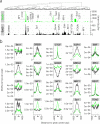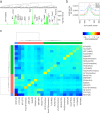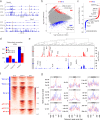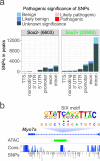Open chromatin dynamics in prosensory cells of the embryonic mouse cochlea
- PMID: 31227770
- PMCID: PMC6588700
- DOI: 10.1038/s41598-019-45515-2
Open chromatin dynamics in prosensory cells of the embryonic mouse cochlea
Abstract
Hearing loss is often due to the absence or the degeneration of hair cells in the cochlea. Understanding the mechanisms regulating the generation of hair cells may therefore lead to better treatments for hearing disorders. To elucidate the transcriptional control mechanisms specifying the progenitor cells (i.e. prosensory cells) that generate the hair cells and support cells critical for hearing function, we compared chromatin accessibility using ATAC-seq in sorted prosensory cells (Sox2-EGFP+) and surrounding cells (Sox2-EGFP-) from E12, E14.5 and E16 cochlear ducts. In Sox2-EGFP+, we find greater accessibility in and near genes restricted in expression to the prosensory region of the cochlear duct including Sox2, Isl1, Eya1 and Pou4f3. Furthermore, we find significant enrichment for the consensus binding sites of Sox2, Six1 and Gata3-transcription factors required for prosensory development-in the open chromatin regions. Over 2,200 regions displayed differential accessibility with developmental time in Sox2-EGFP+ cells, with most changes in the E12-14.5 window. Open chromatin regions detected in Sox2-EGFP+ cells map to over 48,000 orthologous regions in the human genome that include regions in genes linked to deafness. Our results reveal a dynamic landscape of open chromatin in prosensory cells with potential implications for cochlear development and disease.
Conflict of interest statement
The authors declare no competing interests.
Figures






Similar articles
-
Eya1-Six1 interaction is sufficient to induce hair cell fate in the cochlea by activating Atoh1 expression in cooperation with Sox2.Dev Cell. 2012 Feb 14;22(2):377-90. doi: 10.1016/j.devcel.2011.12.006. Dev Cell. 2012. PMID: 22340499 Free PMC article.
-
Dynamic Expression of Sox2, Gata3, and Prox1 during Primary Auditory Neuron Development in the Mammalian Cochlea.PLoS One. 2017 Jan 24;12(1):e0170568. doi: 10.1371/journal.pone.0170568. eCollection 2017. PLoS One. 2017. PMID: 28118374 Free PMC article.
-
A dual function for canonical Wnt/β-catenin signaling in the developing mammalian cochlea.Development. 2012 Dec 1;139(23):4395-404. doi: 10.1242/dev.080358. Development. 2012. PMID: 23132246 Free PMC article.
-
Building the world's best hearing aid; regulation of cell fate in the cochlea.Curr Opin Genet Dev. 2009 Aug;19(4):368-73. doi: 10.1016/j.gde.2009.06.004. Epub 2009 Jul 13. Curr Opin Genet Dev. 2009. PMID: 19604683 Free PMC article. Review.
-
Sox2 regulation of hair cell development: incoherence makes sense.Hear Res. 2013 Mar;297:20-9. doi: 10.1016/j.heares.2012.11.003. Epub 2012 Nov 12. Hear Res. 2013. PMID: 23154195 Review.
Cited by
-
Mapping the regulatory landscape of auditory hair cells from single-cell multi-omics data.Genome Res. 2021 Oct;31(10):1885-1899. doi: 10.1101/gr.271080.120. Epub 2021 Apr 9. Genome Res. 2021. PMID: 33837132 Free PMC article.
-
Developmental GAD2 Expression Reveals Progenitor-like Cells with Calcium Waves in Mammalian Crista Ampullaris.iScience. 2020 Aug 21;23(8):101407. doi: 10.1016/j.isci.2020.101407. Epub 2020 Jul 24. iScience. 2020. PMID: 32771977 Free PMC article.
-
Novel cell types and developmental lineages revealed by single-cell RNA-seq analysis of the mouse crista ampullaris.Elife. 2021 May 18;10:e60108. doi: 10.7554/eLife.60108. Elife. 2021. PMID: 34003106 Free PMC article.
-
Long-range Atoh1 enhancers maintain competency for hair cell regeneration in the inner ear.Proc Natl Acad Sci U S A. 2024 Dec 17;121(51):e2418098121. doi: 10.1073/pnas.2418098121. Epub 2024 Dec 13. Proc Natl Acad Sci U S A. 2024. PMID: 39671177 Free PMC article.
-
3D reconstruction of the mouse cochlea from scRNA-seq data suggests morphogen-based principles in apex-to-base specification.Dev Cell. 2024 Jun 17;59(12):1538-1552.e6. doi: 10.1016/j.devcel.2024.03.028. Epub 2024 Apr 8. Dev Cell. 2024. PMID: 38593801 Free PMC article.
References
Publication types
MeSH terms
Substances
Grants and funding
- R21 DC014768/DC/NIDCD NIH HHS/United States
- T32 GM007270/GM/NIGMS NIH HHS/United States
- T32 DC005361/DC/NIDCD NIH HHS/United States
- T32HD007183/U.S. Department of Health & Human Services | NIH | Eunice Kennedy Shriver National Institute of Child Health and Human Development (NICHD)/International
- F32 DC016480/DC/NIDCD NIH HHS/United States
LinkOut - more resources
Full Text Sources
Molecular Biology Databases

